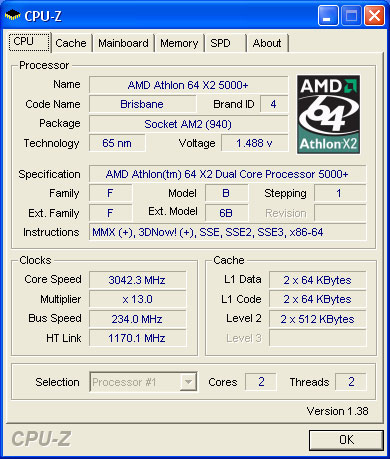Overclocking:
To gauge how far our Athlon 64 X2 5000+ EE sample overclocked, I used the same M2N32 SLI Deluxe motherboard from Asus with the CPU core voltage set to 1.45V in BIOS. In addition, I used Zalman's CNPS9700 heatsink/fan combination with the fan at its default speed setting. I got the chip that AMD sent to us to POST at just short of 3200MHz, but I couldn't get into Windows at this speed.I couldn't get any kind of Prime 95 stability (dual instances) until I lowered theclock speed to just over 3.04GHz using the CPU's default multiplier and a HTT clock of 234MHz. Here's a screenshot of where I got to:

Power Consumption:
No matter what we tried, we couldn't get AMD's Cool 'n' Quiet technology working on our M2N32 SLI Deluxe, so unfortunately, we've had to leave power consumption measurements with power management enabled out for the time being. We've tried several BIOS revisions, including a couple of BETA BIOSes, and none have fixed the issue for us.
Final Thoughts...
I can't help but feel a bit mixed about the first wave of 65 nanometre processors to come from AMD. While the company has done a lot of things right in its transition to 65 nanometres that will be immediately beneficial to itself (rather than to its customers), we can't help but feel that it's priced out of the market a little.The reduction in die size in conjunction with the move to 300mm wafers will enable AMD to alleviate the chip shortage problems it had towards the end of last year, and it will also help it to increase its margins. It has also helped the company to reduce its power consumption somewhat, too. This is probably the only improvement made that is actually passed onto the consumer - every other improvement that we can see is there to benefit the guys in green jackets.
While I believe that's good for the microprocessor industry, it doesn't help AMD out of the hole that it appears to be in at the moment. Currently, the X2 5000+'s main competition comes from Intel's Core 2 Duo E6600 - retail versions of both are priced just over the £200 mark in the UK, with the Athlon being slightly cheaper. However, AMD's problem becomes apparent when you start to look more closely at performance - the E6600 often trades blows with AMD's flagship Athlon 64 FX-62 processor, and is nearly always faster than the Athlon 64 X2 5000+. Add that to the fact that the 65 nanometre Brisbane chip is actually marginally slower than the chip it is replacing, and AMD isn't going to get any more competitive.
The one interesting decision that AMD has made is the increase L2 cache latency on Brisbane - the performance deficit between Brisbane and Windsor wasn't massive, but it was distinguishable and fairly consistent over the course of the application benchmarks we've shown here. This leaves me a little perplexed, but the explanation that there's the potential for 65-nanometre Athlon 64 X2's with larger caches if there is a need to move to much larger cache sizes seems a fair one.
Simply put, it's time for a much-needed update to AMD's K8 architecture. We know that it's coming later this year, but it can't happen soon enough, in our opinion. K8 has been great over the years, but AMD just can't get to high enough frequencies to compete with Intel at the moment. If you're looking to build a new system then the choice is quite a clear one; unless you already own a socket AM2 motherboard, Intel's Core 2 Duo processors are a much better choice.
- Performance
- x
- x
- x
- x
- x
- x
- x
- -
- -
- -
- 7/10
- Value
- x
- x
- x
- x
- x
- x
- -
- -
- -
- -
- 6/10
- Overall
- x
- x
- x
- x
- x
- x
- x
- -
- -
- -
- 7/10

MSI MPG Velox 100R Chassis Review
October 14 2021 | 15:04









Want to comment? Please log in.